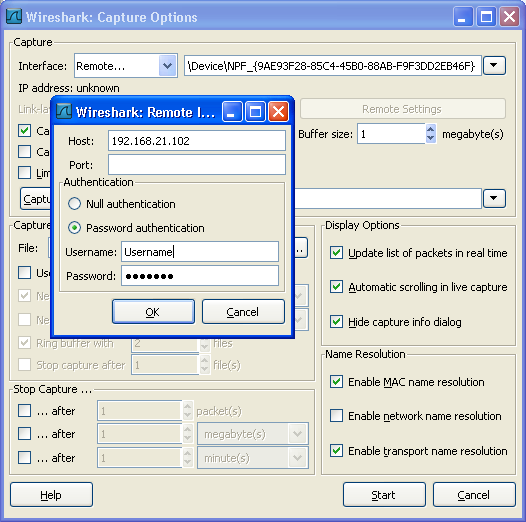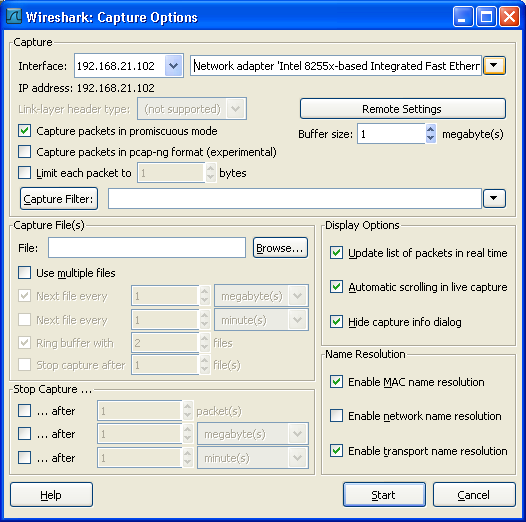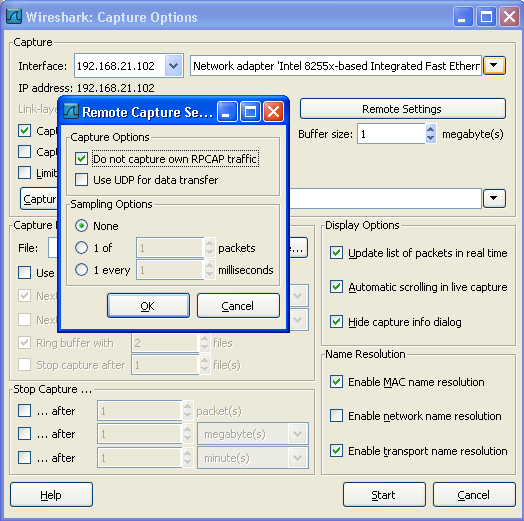Besides doing capture on local interfaces Wireshark is capable of reaching out across the network to a so called capture daemon or service processes to receive captured data from.
![[Note]](wsug_graphics/note.png) | Microsoft Windows only |
|---|---|
This dialog and capability is only available on Microsoft Windows. On Linux/Unix you can achieve the same effect (securely) through an SSH tunnel. |
The Remote Packet Capture Protocol service must first be running on the target platform before Wireshark can connect to it. The easiest way is to install WinPcap from http://www.winpcap.org/install/default.htm on the target. Once installation is completed go to the Services control panel, find the Remote Packet Capture Protocol service and start it.
![[Note]](wsug_graphics/note.png) | Note |
|---|---|
Make sure you have outside access to port 2002 on the target platform. This is the port where the Remote Packet Capture Protocol service can be reached, by default. |
To access the Remote Capture Interfaces dialog use the Interfaces dropdown list on the "Capture Options" dialog, see Figure 4.3, “The "Capture Options" dialog box”, and select "Remote...".
You have to set the following parameter in this dialog:
- Host
Enter the IP address or host name of the target platform where the Remote Packet Capture Protocol service is listening.
- Port
Set the port number where the Remote Packet Capture Protocol service is listening on. Leave open to use the default port (2002).
- Null authentication
Select this if you don't need authentication to take place for a remote capture to be started. This depends on the target platform. Configuring the target platform like this makes it insecure.
- Password authentication
This is the normal way of connecting to a target platform. Set the credentials needed to connect to the Remote Packet Capture Protocol service.
When the connection to the Remote Packet Capture Protocol service is successfully established the "Capture Options" dialog looks like this, see Figure 4.5, “The "Remote Capture" dialog box”.
The Interface dropdown list now shows the IP address or host name of the Remote Packet Capture Protocol service and the other field shows the interfaces on the remote target. After selecting the desired interface just click Start to start the remote capture.
The remote capture can be furhter fine tuned to match your situation. The Remote Settings button gives you this option. It pops up the dialog shown in Figure 4.6, “The "Remote Capture Settings" dialog box”.
You can set the following parameters in this dialog:
- Do not capture own RPCAP traffic
This option sets a capture filter so that the traffic flowing back from the Remote Packet Capture Protocol service to Wireshark isn't captured as well and also send back. The recursion in this saturates the link with duplicate traffic.
You only should switch this off when capturing on an interface other then the interface connecting back to Wireshark.
- Use UDP for data transfer
Remote capture control and data flows over a TCP connection. This option allows you to choose an UDP stream for data transfer.
- Sampling option None
This option instructs the Remote Packet Capture Protocol service to send back all captured packets which have passed the capture filter. This is usually not a problem on a remote capture session with sufficient bandwidth.
- Sampling option 1 of x packets
This option limits the Remote Packet Capture Protocol service to send only a sub sampling of the captured data, in terms of number of packets. This allows capture over a narrow band remote capture session of a higher bandwidth interface.
- Sampling option 1 every x milliseconds
This option limits the Remote Packet Capture Protocol service to send only a sub sampling of the captured data, in terms of time. This allows capture over a narrow band capture session of a higher bandwidth interface.


